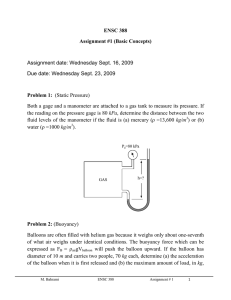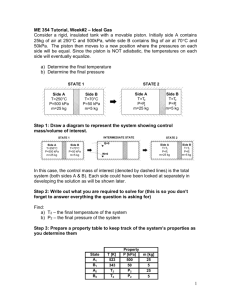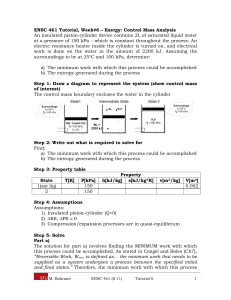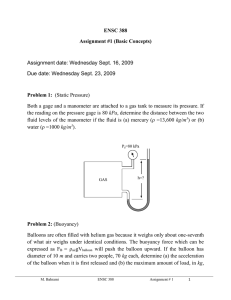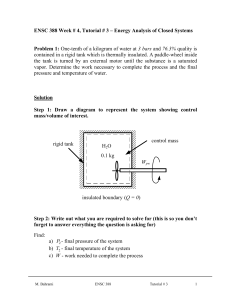Consider a rigid, insulated tank with a movable piston. Initially... contains 25kg of air at 250C and 500kPa, while side... ENSC 461 Tutorial, Week#2 – Ideal Gas
advertisement
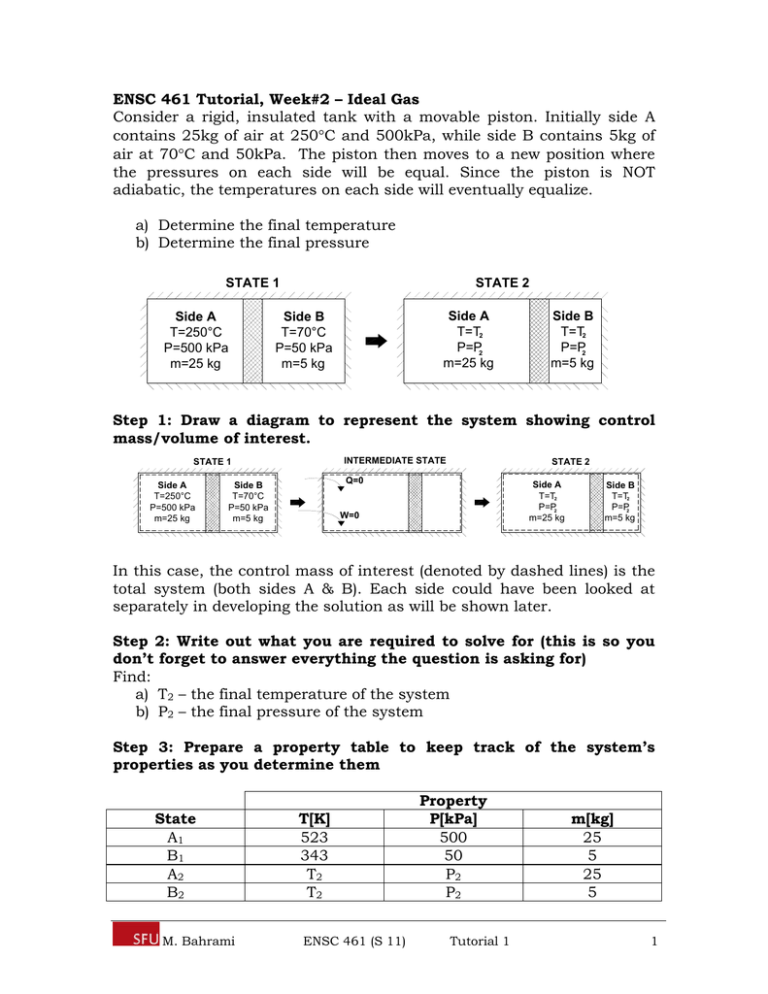
ENSC 461 Tutorial, Week#2 – Ideal Gas Consider a rigid, insulated tank with a movable piston. Initially side A contains 25kg of air at 250C and 500kPa, while side B contains 5kg of air at 70C and 50kPa. The piston then moves to a new position where the pressures on each side will be equal. Since the piston is NOT adiabatic, the temperatures on each side will eventually equalize. a) Determine the final temperature b) Determine the final pressure STATE 2 STATE 1 Side A T=250°C P=500 kPa m=25 kg Side A T=T2 P=P2 m=25 kg Side B T=70°C P=50 kPa m=5 kg Side B T=T2 P=P2 m=5 kg Step 1: Draw a diagram to represent the system showing control mass/volume of interest. INTERMEDIATE STATE STATE 1 Side A T=250°C P=500 kPa m=25 kg STATE 2 Q=0 Side B T=70°C P=50 kPa m=5 kg Side A T=T2 P=P2 m=25 kg W=0 Side B T=T2 P=P2 m=5 kg In this case, the control mass of interest (denoted by dashed lines) is the total system (both sides A & B). Each side could have been looked at separately in developing the solution as will be shown later. Step 2: Write out what you are required to solve for (this is so you don’t forget to answer everything the question is asking for) Find: a) T2 – the final temperature of the system b) P2 – the final pressure of the system Step 3: Prepare a property table to keep track of the system’s properties as you determine them State A1 B1 A2 B2 M. Bahrami T[K] 523 343 T2 T2 ENSC 461 (S 11) Property P[kPa] 500 50 P2 P2 Tutorial 1 m[kg] 25 5 25 5 1 Step 4: State your assumptions (you may have to add to your list of assumptions as you proceed in the problem) Assumptions: 1) Rigid Tank – the air does NOT do work on the tank walls. 2) Insulated Tank – there is NO heat transfer from the tank to the surroundings. 3) Air is modelled as an ideal gas with constant specific heats over the temperature range of interest 4) Piston is NOT adiabatic so heat transfer can occur between sides A & B allowing for an equalization of temperature at state 2 5) KE, PE 0 Part a) Step 5: Calculations (usually start by writing first and second laws) The First Law for a closed system can be expressed as Eq1. E W 1 12 Q 12 (Eq1) E2 With our choice of the control mass boundary and the assumption of a rigid, insulated tank, the work and heat transfer terms in Eq1 will be zero, reducing Eq1 to Eq2 as shown below. (Eq2) E E 0 2 1 Recalling that E = U + KE +PE, Eq2 can be expanded into Eq3. U U KE KE PE PE 0 2 2 1 1 2 1 (Eq3) With the assumption that KE and PE are approximately equal to zero, Eq3 reduces to Eq4. U U 2 1 (Eq4) 0 The internal energy, U, of the control mass (total system) is composed of the internal energy of side A, UA, and the internal energy of side B, UB. Eq4 can be re-expressed in terms of the internal energies of side A & B at each state as shown in Eq5. U A2 U B 2 U A1 U B1 0 (Eq5) Rearranging and re-expressing Eq5 in terms specific internal energies (Recall U = mu), Eq6 is obtained. M. Bahrami ENSC 461 (S 11) Tutorial 1 2 m u A A2 u A1 m B u B 2 u B1 0 (Eq6) Using the Ideal Gas Relation, u2 – u1 = cv(T2 – T1), Eq6 can be rewritten in terms of the system’s temperatures as shown in Eq7. m c T A v T A1 m B c v T B 2 T B1 0 A2 (Eq7) As stated in the problem the piston is not adiabatic, so heat transfer will be permitted across it allowing for the temperatures of sides A & B to equalize. Introducing TA2 = TB2 = T2 into Eq7 and isolating for T2, gives Eq8 – an equation for the final temperature of the system in terms of known quantities. T 2 m T m T m m A A1 B A B (Eq8) B1 Substituting in values from the property table into Eq8 gives the solution for the final temperature of the system. T 2 (25)(523)[kg K ] (5)(343)[kg K ] = (25 5)[kg ] 493K or 220C Answer a) Part b) To solve for the final pressure of the system we can make use of the Ideal Gas Law to express the pressure at state 2, P2, in two ways: the first in terms of the properties of side A, as shown in Eq9, the second in terms of the properties of side B, as shown in Eq10. PV 2 A2 mA R T 2 (Eq9) PV B2 mB R T 2 (Eq10) 2 Adding Eq9 & Eq10, an expression for the pressure at state 2 is obtained in terms of the known quantities (mA, mB, R, T2) as shown in Eq11. The volumes of each side at state 2 (VA2 & VB2) are still unknown. P 2 m R T m R T V V A 2 A2 B (Eq11) 2 B2 The denominator of Eq11, VA2 + VB2, is equal to the total volume. The total volume of the system does not change during the process because we have assumed a rigid tank so, VA2 + VB2 =VTotal = VA1 + VB1. Eq11 can be re-expressed in terms of VA1 & VB1 as shown in Eq12. M. Bahrami ENSC 461 (S 11) Tutorial 1 3 P 2 m R T m R T V V 2 B A1 B1 A (Eq12) 2 VA1 and VB1 can be determined from applying the Ideal Gas Law to side A and side B at state 1 as shown in Eq13 and Eq14. V A1 m RT P A A1 (Eq13) B1 (Eq14) A1 V B1 m RT P B B1 Substituting in Eq13 and Eq14 into Eq12 for VA1 & VB1, an expression, Eq15, for the system pressure at state 2 is found in terms of known quantities. P 2 m R T m R T m R T m R T P P 2 A A1 A 2 B B A1 B1 B1 (Eq15) Dividing out the gas constant, R, in Eq15 gives Eq16 P 2 m m T A B 2 mAT A1 mBT B1 PA1 PB1 (Eq16) Substituting in values from the property table in Eq16 gives the solution for the final system pressure. P 2 (25 5)(493)[kg K ] (25)(523)[kg K ] (5)(343)[kg K ] 500[kPa] 50[kPa] = 244.7 kPa Answer b) Step 6: Concluding Statement The final system temperature and pressure were found to be 220C and 244.7 kPa respectively. M. Bahrami ENSC 461 (S 11) Tutorial 1 4 Alternative Approach to Part a) Rather than choosing the control mass boundary to enclose the whole system, side A and B could have been analyzed separately. The diagram below shows the separate control masses defined in each case. Side A Side B STATE 1 STATE 1 Side A T=250°C P=500 kPa m=25 kg Side B T=70°C P=50 kPa m=5 kg INTERMEDIATE STATE INTERMEDIATE STATE Q Q W W STATE 2 STATE 2 Side A T=T2 P=P2 m=25 kg Side B T=T2 P=P2 m=5 kg Writing the First Law equation for Side A and Side B gives Eq17 & Eq18 (Eq17) E A1 W 12 Q12 E A2 E W B1 1 2 Q 1 2 E (Eq18) B2 Combining Eq17 & Eq18 gives Eq19, which is equivalent to Eq2. E A2 E B 2 E A1 E B1 0 E 2 E1 0 (Eq19) The remainder of the solution can be obtained by following the same steps as before, starting at Eq2. M. Bahrami ENSC 461 (S 11) Tutorial 1 5
